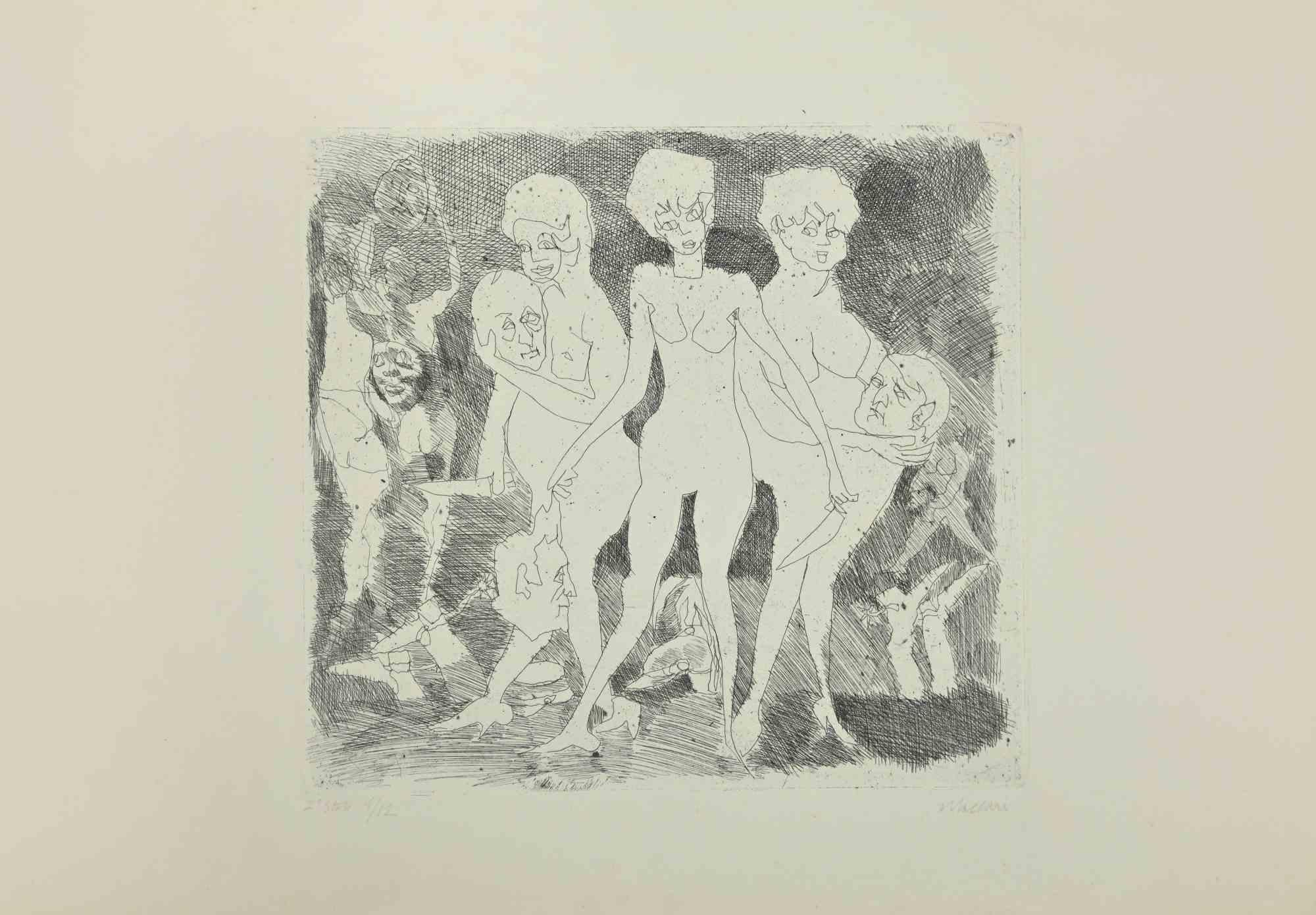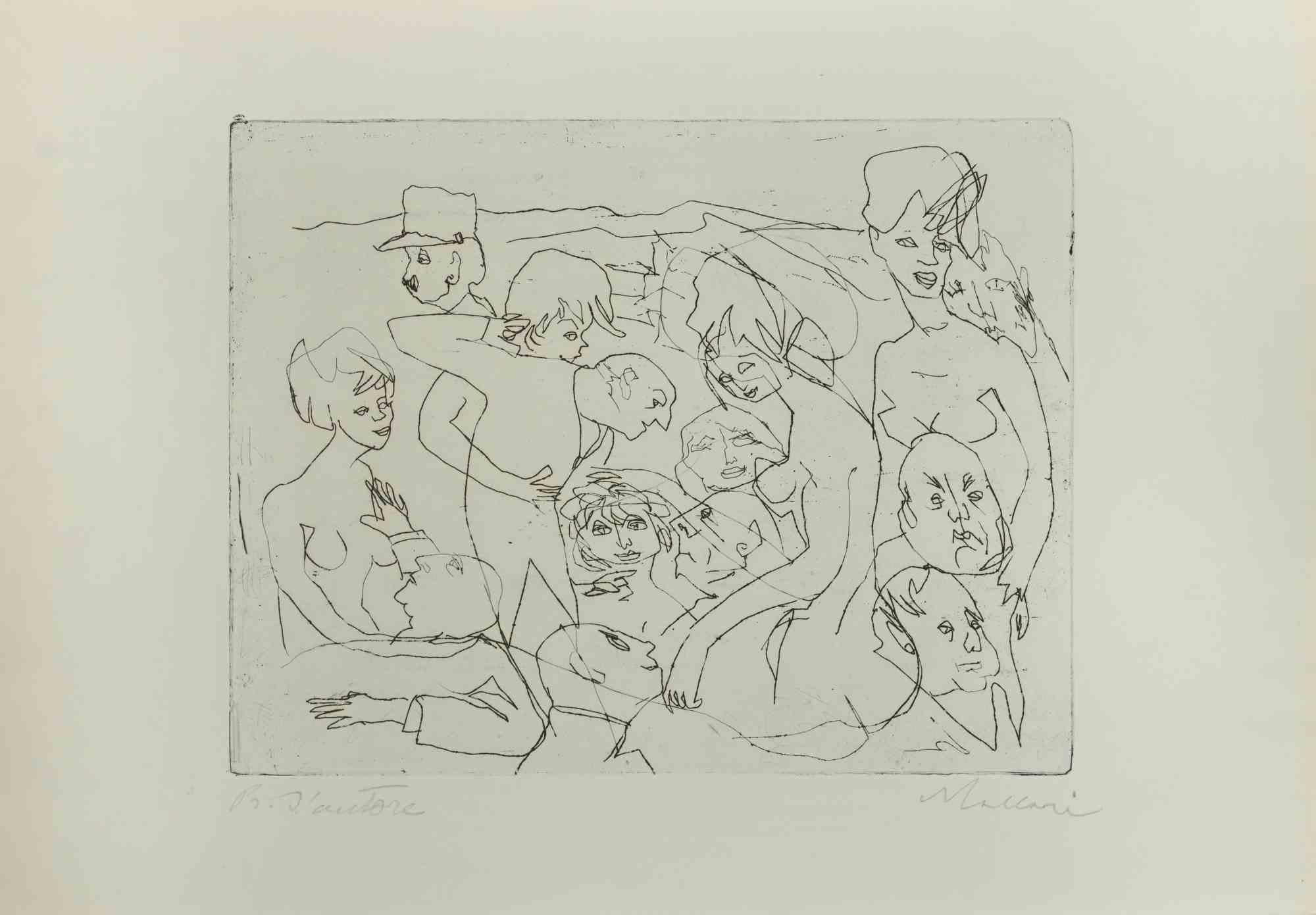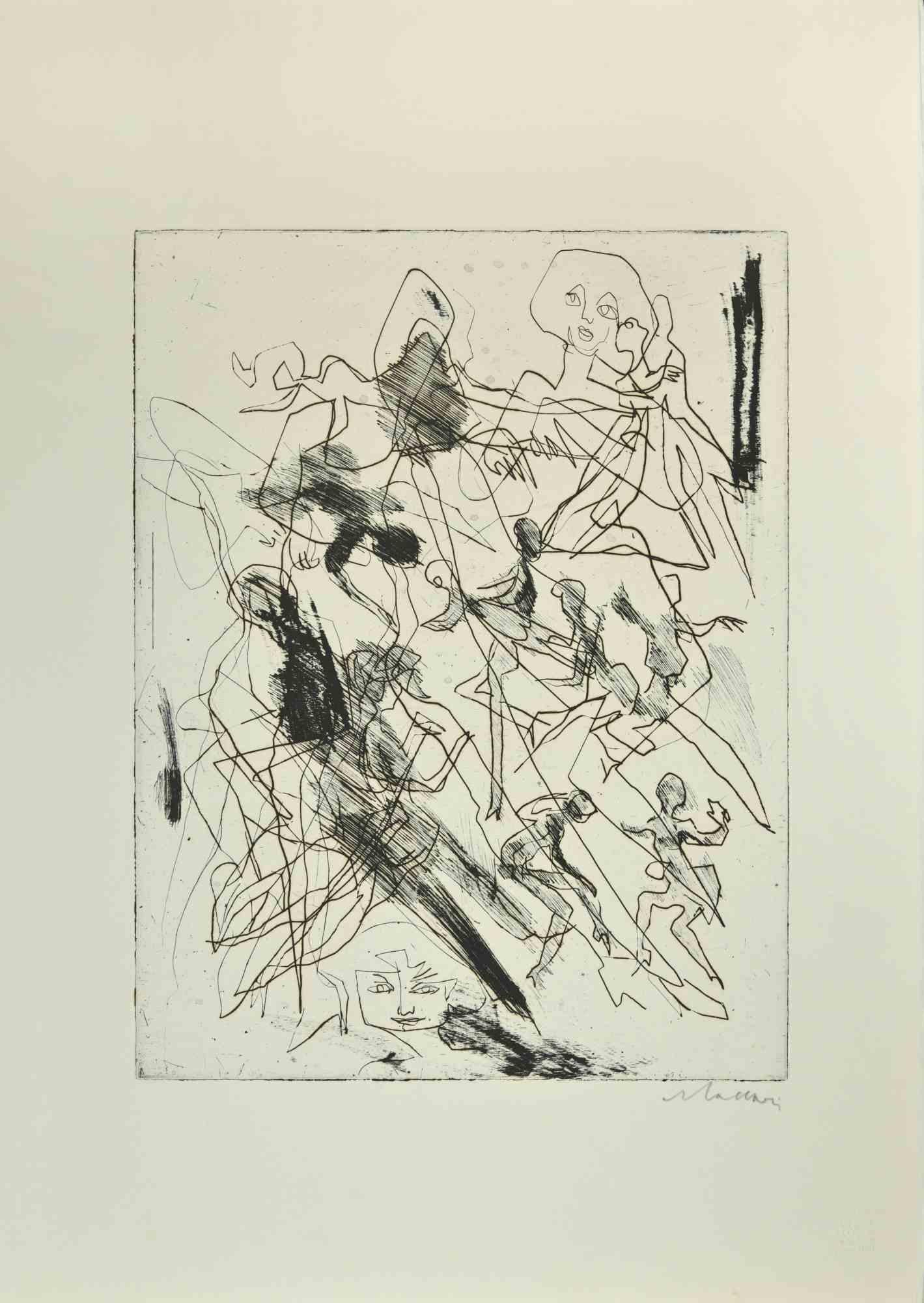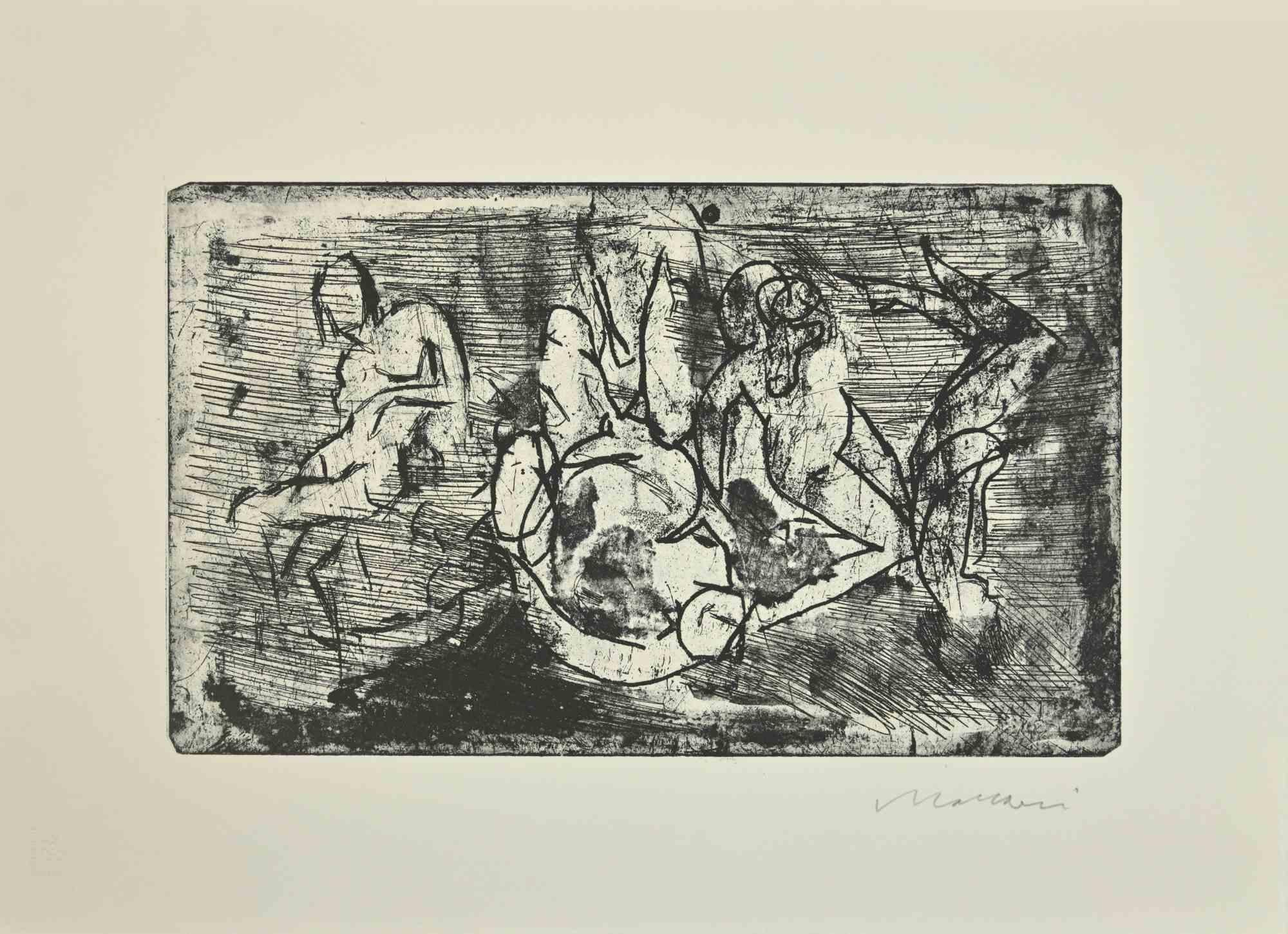Items Similar to Mother and Child
Want more images or videos?
Request additional images or videos from the seller
1 of 10
Peter Laszlo PeriMother and Child1940s
1940s
About the Item
A beautiful and touching original Peter László Péri etching, 1940s. A beaming mother of gigantic proportions holds her child above her head. At her feet, a number of small characters also live their family lives.
Artist: Peter László Péri
Date: 1940s
Framed size: 37cm x 83cm
Mounting: Raised-float mounted using acid-free Japanese wheat-starch paste and Japanese paper
Framing: Museum-grade oak frame with 99% UV-resistant glass
Peter László Péri (1899 – 1967) was a Hungarian artist and sculptor renowned for his constructivist artworks in the 1920s. He was involved in the Hungarian avant-garde from an early age, joining Janos Macza’s innovative theatre workshop in 1917. After moving to and being expelled from Paris for sedition, he settled in Berlin, becoming close with a group of exiled left-wing Hungarian avant-garde artists. An émigré to England in 1933 from Nazi-occupied Germany, Péri worked more figuratively after the war.
Two of his sculptural relief works are on display at Tate Britain in the Historic and Modern British Art section 1920-1940, and several of his works are in MoMA. His long-lost Festival of Britain sculpture 'The Sunbathers' was recently restored and installed at Waterloo Station. A new exhibition celebrating Péri's work from the period after he emigrated has opened in Berlin at Kunsthaus Dahlem. The collection that we have for sale is largely from this period of his life.
- Creator:Peter Laszlo Peri (1899 - 1967, Hungarian)
- Creation Year:1940s
- Dimensions:Height: 32.68 in (83 cm)Width: 14.57 in (37 cm)
- Medium:
- Movement & Style:
- Period:
- Condition:
- Gallery Location:London, GB
- Reference Number:1stDibs: LU2333213725092
Peter László Péri (1899 – 1967) was a Hungarian artist and sculptor renowned for his constructivist artworks in the 1920s. He was involved in the Hungarian avant-garde from an early age, joining Janos Macza’s innovative theatre workshop in 1917. After moving to and being expelled from Paris for sedition, he settled in Berlin, becoming close with a group of exiled left-wing Hungarian avant-garde artists. An émigré to England in 1933 from Nazi-occupied Germany, Péri worked more figuratively after the war. Two of his sculptural relief works are on display at Tate Britain in the Historic and Modern British Art section 1920-1940, and several of his works are in MoMA. His long-lost Festival of Britain sculpture 'The Sunbathers' was recently restored and installed at Waterloo Station. A major exhibition celebrating Péri's work from the period after he emigrated opened in Berlin at Kunsthaus Dahlem.
About the Seller
5.0
Vetted Seller
These experienced sellers undergo a comprehensive evaluation by our team of in-house experts.
Established in 2020
1stDibs seller since 2023
- ShippingRetrieving quote...Ships From: London, United Kingdom
- Return PolicyThis item cannot be returned.
More From This SellerView All
- Variations On The Theme ‘Mother And Child’Located in London, GBA beautiful 1940s etching representing scenes of motherhood, from Péri’s observations of people on the streets of London. Artist: Peter László Péri...Category
1940s Modern Figurative Prints
MaterialsPaper, Etching
- Variations on the Theme ‘Window’ - NeighboursLocated in London, GBA striking etching, from Péri’s observations of people on the streets of London. Artist: Peter László Péri Date: 1940s Framed size: 40cm x 50cm Mou...Category
1940s Modern Figurative Prints
MaterialsEtching, Paper
- 'Londoners' 1940s Etchings - LoveLocated in London, GBThree etchings representing the cycle of love, from Péri’s observations of people on the streets of London. These small prints were intended to be sold in groups as folding booklets, like postcards. Artist: Peter László Péri...Category
1940s Modern Figurative Prints
MaterialsEtching
- 'Londoners' 1940s EtchingLocated in London, GBA beautiful etching from Péri’s observations of people on the streets of London. Artist: Peter László Péri Date: 1940s Framed size: 26.5cm x 32cm M...Category
1940s Modern Figurative Prints
MaterialsEtching
- 'Londoners' 1940s EtchingsLocated in London, GBThree etchings from Péri’s observations of people on the streets of London. These small prints were intended to be sold in groups as folding booklets, like postcards. The top etching is closely reminiscent of Péri’s “Class System” which is in the Tate collection (as pictured). “In Class System 1946 (Tate P14973) Peri used close observation of social difference to make a political point about reconstruction and inequality after the end of the Second World War. On the left a man dressed in a suit and hat stands on the pavement, his hand on his hip, leaning on his umbrella. On the right the same pose is adopted by a man standing in the road, wearing a flat cap, shirt-sleeves and heavy boots, but he leans on a pneumatic drill. The figures are clearly identified as upper class and working class by their clothing, and the composition juxtaposes the idleness of the man standing on the pavement with the active manual labourer ready to begin work, implying their relative contribution to the reconstruction of Britain in the aftermath of the Second World War.” Artist: Peter László Péri Date: 1940s Framed size: 22 x 42cm Mounting: Raised-float mounted using acid-free Japanese wheat-starch paste and Japanese paper...Category
1940s Figurative Prints
MaterialsEtching, Paper
- Selling the Daily Worker - by Peter László PériLocated in London, GBA uniquely hand-coloured etching with acquatint also represented in the Tate collection: “Selling the Daily Worker c.1947 (Tate P14975) is an etching that depicts a woman selling the Communist newspaper The Daily Worker with the headline ‘The British Turn to Socialism’. She is standing in front of a factory wall, her baby in its pram temporarily ignored. The Daily Worker reached its peak circulation in the years after the Second World War, when concerns about workers’ rights and inequality inspired many to turn to socialism. ” Artist: Peter László Péri...Category
1940s Constructivist Figurative Prints
MaterialsEtching
You May Also Like
- Comic Poems - Rare Book Illustrated by G. Cruikshank - 1830By George CruikshankLocated in Roma, ITComic Poems ("Seven illustrated books in one volume") is an original modern rare book illustrated by George Cruikshank (London, 1792 - London, 1878) in 1829/1830. Published by Johnston, London. Original First Edition. Seven books bound in one volume (Tom Thumb, The real Devil’s Walk, Monsieur Tonson, The March of intellect, The Devil’s Walk, Steamers v. Stages and The Epping Hunt). Format: in 12°. The book includes Fortyfive etchings and woodcuts. Mint conditions. George Cruikshank (London, 1792 - London, 1878) was a British caricaturist and book illustrator, praised as the "modern Hogarth" during his life. His book illustrations for his friend di lui Charles Dickens, and many other authors, reached an international audience. For Charles Dickens, Cruikshank illustrated Sketches by Boz...Category
1830s Modern More Art
MaterialsPaper, Etching, Woodcut
- Figures - Drypoint by Mino Maccari - Mid-20th CenturyBy Mino MaccariLocated in Roma, ITMid-20th Century. Hand-signed in the lower right part. Numbered. Edition 1/12. Good conditions. Mino Maccari (Siena, 1924-Rome, June 16, 1989) was an Italian writer, painter, engraver and journalist, winner of the Feltrinelli Prize for Painting in 1963 and first winner of the Forte dei Marmi Satira Prize in 1973.After completing his secondary education, he enrolls in university. An interventionist like many young people of his time, he took part in the Great War at the age of nineteen as a field artillery officer. At the end of the conflict he resumed his university studies in Siena and in 1920 he graduated in law. In 1924 he was called by Angiolo Bencini to take care of the printing of the magazine Il Selvaggio, openly uncompromising fascist, revolutionary and anti-bourgeois, where his first engravings were published. After a few years of coexistence between work at the newspaper and the law firm, at the beginning of 1926 he left the legal profession to take over the direction of Il Selvaggio which he would hold until 1942. In 1928 he was the author of the small book published by Vallecchi (Florence), Il Trastullo di Strapaese (little songs and engraved woodwinds) which collected fascist songs (the same book was seized several times from Antonio Gramsci during his detention). With the transfer of the editorial staff of the Selvaggio in 1925 from Colle di Val d'Elsa to Florence, Maccari collaborated with Ardengo Soffici, Ottone Rosai and Achille Lega. In the meantime, between 1927 and 1930, he made himself known to the general public as a painter by participating in various national exhibitions. Also in 1930 Maccari works in Turin at La Stampa as editor-in-chief and has the writer Curzio Malaparte as director. His presence in the cultural and editorial world of the fascist regime is very intense, he writes and collaborates with various magazines: Quadrivio, L'Italia Letteraria, L'Italiano and Omnibus by Leo Longanesi; then, during the war, in il Primato di Bottai and, subsequently again, in Il Mondo di Pannunzio (from the first number, in 1949), up to Documento by Federigo Valli. His graphic production is also vast, ranging from the Album of Vallecchi (1925), Il trastullo di Strapaese (1928) to Linoleum (1931). Maccari illustrated in 1934 La vecchia del Bal Bullier by Antonio Baldini and in 1942 he published the Album folder, followed by Come quando fuori Piove and Il superfluo illustrata.For his pictorial work full of evident chromatic accentuations and fast brushstrokes, the violent drawing combined with the lively stroke of the graphic sign of his engravings, he is recognized by critics as a complete artist. In 1962 he was also entrusted with the presidency of the Accademia di San Luca in Rome and managed to obtain a personal exhibition at Gallery 63 in New York. His production of drawings, watercolors, temperas, etc. is endless, sometimes in collaboration with prestigious publishing houses; it is worth mentioning, just as an excellent example, the 32 b/w and color drawings with which he illustrated Il gusto di vivere, a volume that collects writings by Giancarlo Fusco, edited by Natalia Aspesi and published by Laterza in 1985. Maccari, Sienese and great contradaiolo della Torre, painted the Palio...Category
Mid-20th Century Modern Figurative Prints
MaterialsPaper, Drypoint, Etching
- Figures - Etching by Mino Maccari - 1940sBy Mino MaccariLocated in Roma, ITFigures is an Etching realized by Mino Maccari in the 1940s. Hand-signed in the lower right part. Artist's Proof. Good conditions. Mino Maccari (Siena, ...Category
1940s Modern Figurative Prints
MaterialsPaper, Etching
- Figures - Etching by Mino Maccari - Mid-20th CenturyBy Mino MaccariLocated in Roma, ITFigures is an Etching realized by Mino Maccari in the Mid-20th Century. Hand-signed in the lower right part. Good conditions. Mino Maccari (Siena, 1924-Rome, June 16, 1989) was...Category
Mid-20th Century Modern Figurative Prints
MaterialsPaper, Etching
- Figures - Drypoint by Mino Maccari - Mid-20th CenturyBy Mino MaccariLocated in Roma, ITFigures is an Etching and Drypoint realized by Mino Maccari in the Mid-20th Century. Hand-signed in the lower right part. Good conditions. Mino Maccari (Siena, 1924-Rome, June ...Category
Mid-20th Century Modern Figurative Prints
MaterialsPaper, Drypoint, Etching
- Figures - Etching by Mino Maccari - Mid-20th CenturyBy Mino MaccariLocated in Roma, ITFigures is an Etching realized by Mino Maccari in the Mid-20th Century. Handisigned in the lower right part. Numbered. Edition 4/12. Good conditions. Mino Maccari (Siena, 1924-Rome, June 16, 1989) was an Italian writer, painter, engraver and journalist, winner of the Feltrinelli Prize for Painting in 1963 and first winner of the Forte dei Marmi Satira Prize in 1973.After completing his secondary education, he enrolls in university. An interventionist like many young people of his time, he took part in the Great War at the age of nineteen as a field artillery officer. At the end of the conflict he resumed his university studies in Siena and in 1920 he graduated in law. In 1924 he was called by Angiolo Bencini to take care of the printing of the magazine Il Selvaggio, openly uncompromising fascist, revolutionary and anti-bourgeois, where his first engravings were published. After a few years of coexistence between work at the newspaper and the law firm, at the beginning of 1926 he left the legal profession to take over the direction of Il Selvaggio which he would hold until 1942. In 1928 he was the author of the small book published by Vallecchi (Florence), Il Trastullo di Strapaese (little songs and engraved woodwinds) which collected fascist songs (the same book was seized several times from Antonio Gramsci during his detention). With the transfer of the editorial staff of the Selvaggio in 1925 from Colle di Val d'Elsa to Florence, Maccari collaborated with Ardengo Soffici, Ottone Rosai and Achille Lega. In the meantime, between 1927 and 1930, he made himself known to the general public as a painter by participating in various national exhibitions. Also in 1930 Maccari works in Turin at La Stampa as editor-in-chief and has the writer Curzio Malaparte as director. His presence in the cultural and editorial world of the fascist regime is very intense, he writes and collaborates with various magazines: Quadrivio, L'Italia Letteraria, L'Italiano and Omnibus by Leo Longanesi; then, during the war, in il Primato di Bottai and, subsequently again, in Il Mondo di Pannunzio (from the first number, in 1949), up to Documento by Federigo Valli. His graphic production is also vast, ranging from the Album of Vallecchi (1925), Il trastullo di Strapaese (1928) to Linoleum (1931). Maccari illustrated in 1934 La vecchia del Bal Bullier by Antonio Baldini and in 1942 he published the Album folder, followed by Come quando fuori Piove and Il superfluo illustrata.For his pictorial work full of evident chromatic accentuations and fast brushstrokes, the violent drawing combined with the lively stroke of the graphic sign of his engravings, he is recognized by critics as a complete artist. In 1962 he was also entrusted with the presidency of the Accademia di San Luca in Rome and managed to obtain a personal exhibition at Gallery 63 in New York. His production of drawings, watercolors, temperas, etc. is endless, sometimes in collaboration with prestigious publishing houses; it is worth mentioning, just as an excellent example, the 32 b/w and color drawings with which he illustrated Il gusto di vivere, a volume that collects writings by Giancarlo Fusco, edited by Natalia Aspesi and published by Laterza in 1985. Maccari, Sienese and great contradaiolo della Torre, painted the Palio...Category
Mid-20th Century Modern Figurative Prints
MaterialsPaper, Etching






